Preamble: Things ain’t what they used to be” is a refrain we often hear but were they so good in the old days? These two letters describing Marple Bridge and Mellor in the 1920s and 1930s give a picture of life as it was.
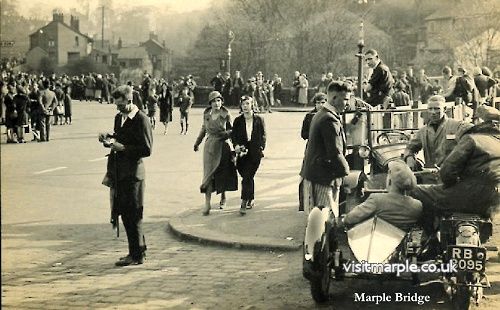
Bill Hughes and Marion Woods,were both born in the first decade of the 20th century and their memories, written in 1983 and 1978, lend an unequalled immediacy to the past.
Letter dated August 1983 from Bill Hughes who lived in Gee Cross, Hyde.
Having reached the autumnal years of life, and now living alone, I often recall the happy memories of those halcyon days before the last war, which I spent in Marple Bridge and the surrounding countryside.
My earliest memories of Marple Bridge date back to 1925 when Brabyns Brow, a narrow road, had huge trees on either side, whose branches festooned with crows nests, overhung the road almost blotting out the daylight.
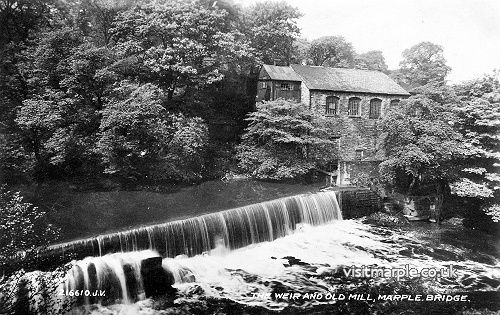
On the banks of the River Goyt adjacent to the weir, was an old corn mill (above) with a large iron waterwheel, which along with Marple Hall was pulled down, in the name of progress by the near-sighted council.
Beyond the shops in Town Street, facing the river, stands a row of cottages which resembles being transported in time to a bygone era.
I well remember when I was a Boy Scout walking from my home in West Gorton Manchester via Reddish Vale to Marple, and camping on the banks of the river, below the aqueduct, and using the polluted water to cook our meals.
In the early 1930s many people from Manchester built a colony of wooden shacks in the Ludworth area, which were used for weekends and holidays where they enjoyed the freedom and fresh air of the country, away from the smoke and grime of their environment in the city.
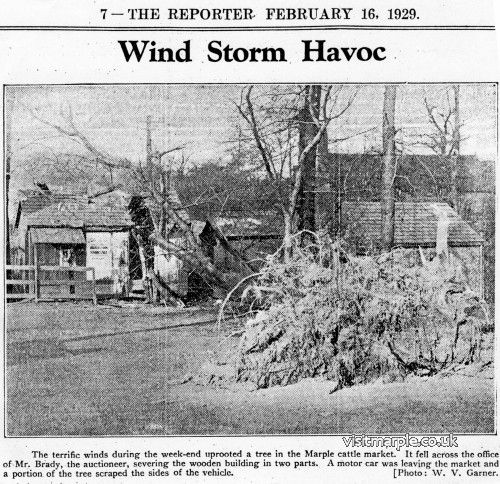
Another recollection was market day at the Cattle Market (above) opposite the station when the farmers assembled in the Norfolk Arms which had an all-day licence, to cater for their thirst and facilitate their business transactions.
Saturday was a revelation and a sight to behold, when hundreds of young male and female hikers and campers alighted at Marple Station, many carrying picks and shovels, bound for Ludworth, which resembled a gold strike at Klondyke.
In the evenings all the local pubs were bulging at the seams with these young carefree people laughing and singing to the accompaniment of ukuleles and banjos.
On Sundays, thousands of day trippers arrived in Marple all bound for the Roman Lakes where they picnicked in the nearby fields, and rowed on the lake, and spent their pennies in the slot machines. Many of the local inhabitants sold pots of tea, jugs of hot water and sold bunches of flowers from tables outside their cottages.
In those far off days, we didn’t realise that Samuel Oldknow was responsible for building these lakes and the famous pack horse bridge, and neither were Roman in origin. Alas, the Roman Lakes lost their popularity with many Mancunians, when cheap day trips to Blackpool and Southport came into being. (Evening trips half a crown on Saturdays).
In my early twenties, along with several pals, dressed up in our “plus-fours” and “flannel bags” spent our weekends at the Little Mill in Rowarth, being charged half a crown for bed and breakfast and sixpence for a pint of beer.
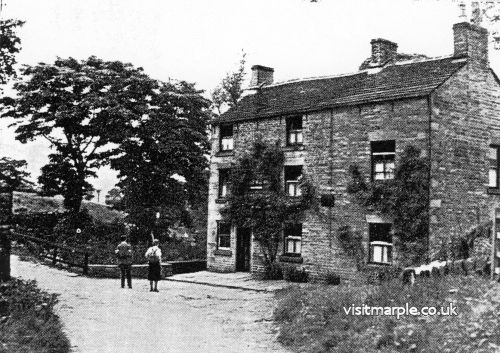
Rowarth, Little Mill Inn
We ‘townies’ from Manchester thought we were the “bees knees” but on more than one occasion the “locals” took us down a peg but it was all in good spirit and we made many friends.
I well recall Mr Slinger, the landlord of the Devonshire Arms, Mellor, charging us sixpence to see the Water Otter in the backyard and when taken to see this creature, was shown a rusty iron kettle on the wall, which was the “water hotter”.
There was the old local in the Norfolk, who sold one of us a racing pigeon, which needless to say flew back to its loft in Marple on its first flight, and goodness knows how many times this occurred each time he sold the same bird.
On Sunday evening before catching the last train back to Ashburys Station, all the young local females using to promenade up and down Brabyns Brow and many were the times we managed to “pick up” and go for a “kiss and a cuddle” in Brabyns Park.
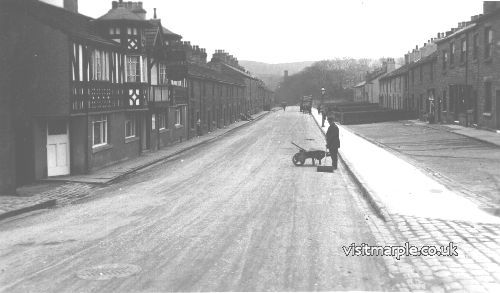
Spring Gardens in quieter times
My father in his youth travelled from Manchester to the Spring Gardens Hotel, Marple Bridge, when they had an open air wooden dance floor and small menagerie outside, and on one occasion the famous tight rope walker, by the name of Blondin, walked on a rope across the River Goyt from the pub, also he walked across Niagara Falls.
At one stage, four of us built a wooden hut in Thornsett where we spent many happy weekends and later built another below Combs Reservoir, Whaley Bridge.
These are but a few of my memories of Marple Bridge before the war, but I have many more stories to relate, for when I got married, I became a local resident in the area, for over fifteen years, before moving to my present home. In many respects Marple Bridge has retained much of its rural atmosphere, which cannot be said of Marple and I would very much like to return to the district but I regret that this is not possible.

My memories of a “Day in the Country” were such that I planned to return one day, and settle down in the district where I achieved and enjoyed every moment, having lived in Cote Green Lane, Cote Green Road, Longhurst Lane and in a cottage called Capstone on top of Cobden Edge, Mellor.
At one time my wife and I opened a café in Low Lea Road, Marple Bridge, which was called the Coffee Inn, which we operated for eight years.
Since my retirement I have written a book on the Local History and articles for the Evening News and have just finished writing my memoirs, which needless to say incorporate much about Marple Bridge and district.
Kind regards, Bill Hughes
------
Letter dated January 1978 from Mrs Marion Woods of Sheffield to Mr and Mrs Marsden, licensees of the Oddfellows Arms, Moor End, Mellor.
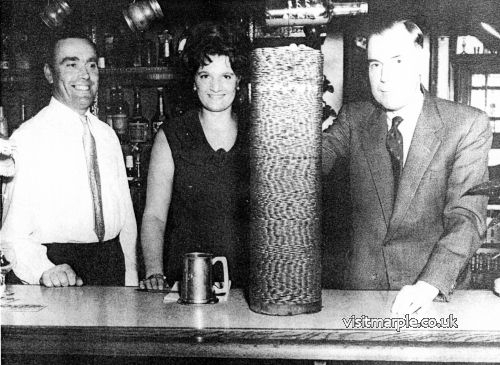
Frank and Grace Marsden, landlord and landlady of the Oddfellows Arms from 1968.
The pennies in the photo above were collected for the Cripples' Help Society. The customer on the right is Frank Wilson - his job being to knock over the pile which was collected in a sheet.
Dear Mr and Mrs Marsden,
In last week’s issue of the Reporter stirred-up many memories of the past in my mind, some of which, I am writing in the hope you might be interested. I am 75 years of age now, and remember well being taken as a child to my grandmother’s house opposite, then called “Rock Cottage”. I would not know if it had since been re-named but I only left the district to come here 2 years ago and, unfortunately had not been able to get to Mellor Church to my parents’ grave for 12 years previous to that, as I am very disabled now and have been for some years. My name was “Marsland” and there may be older customers who remember “the Marsland Family”.
What I would like to tell you is that my father was born in Rock Cottage in 1858. My mother came to Mellor when she was 19 from near Derby. She died in Marple when she was 85, and both parents are in Mellor Churchyard opposite the school. Grandma had 6 sons and 4 daughters. My father’s family consisted of – Henry, Thomas, James, Cephas, Joseph & Ralph Marsland. Sarah, Elizabeth, Martha, and Margaret, all Marslands, all born at Rock Cottage. The Oddfellow was there then, as I heard mother say grandma grumbled as grandfather spent too much time and money there for her liking, but too died at 46, and left her with 10 to bring up.
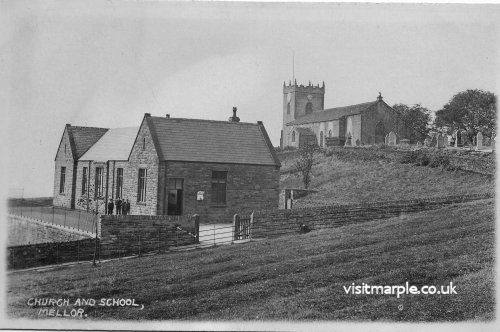
One daughter “Margaret” was a teacher at Thornsett for many years then she taught at the school (above) just below the churchyard. All the sons got on in the world (except my father who died at 46) and Thomas left £500 to Mellor Church when he died. He is buried with his wife, and nearly all the other Marslands in the family vault. Thomas had that big room built on to the side of Rock Cottage for his mother. His brother Henry had a coal business and removal van in Marple Station Yard, and Joseph lived near Lingard’s Mill and was Rate Collector at that time for Hayfield and District. Elizabeth married a Mr Smith headmaster of Mellor School at that time.
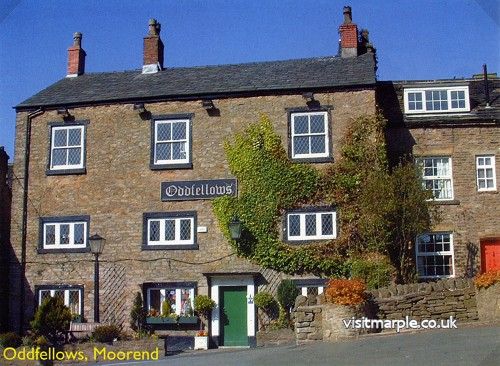
Oddfellows Arms
My mother and father had 3 children whilst keeping Mellor Post Office, Horace, Arnold and Florence (all 3 now dead) Spring Bank they called it, and I was named after mother’s friend in Mellor – “Marion”. Mother remembered when there was not a house leaving Marple Bridge until Mellor village was reached. She told me about the 3 storey cottages on rise going towards Spring Bank, and that weavers used the top rooms to weave material. I never entered the Oddfellow until in my late 20s, but remember a flag floor, and what I thought then as a very old place. My mother passed on to me a lot of local information, both of Marple (where she lived as a widow many years) and Mellor. Sadly a lot of this will die with me, as I have only one sister alive and she has no memory of her youth, and is not interested but for my age yet, my memory is a wonderful one.
My mother brought 5 of us up alone. I know a lot about “Samuel Oldknow” and his Mill too, and of life as it was at that time. There was a Mr Potts who had a shop there and my mother used to use her own coal and bake bread for him for 6d per dozen. I still have one of her old loaf tins.
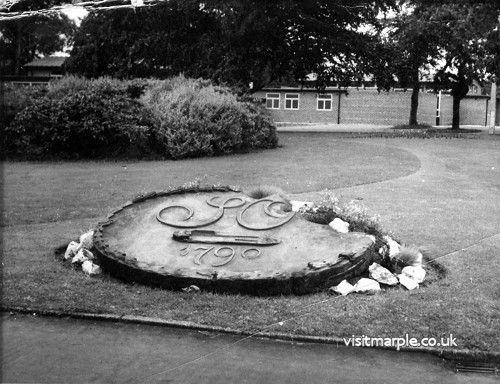
Samuel Oldknow's Shuttle Stone from Mellor Mill in the Memorial Park
Although I have a lovely Council bungalow here my heart is still in the Marple/Romiley/Bredbury district. I lost my husband after I had been here only 6 months, and have applied to come back, but I do not think I shall ever make it now, as they (Stockport Council) do not seem sympathetic. My father knew, very well, the present Miles Arnfield’s grandfather, also called “Miles” and both my parents loved Mellor all their lives.
I hope my letter has interested you, I think Rock Cottage was a small holding at one time, until Uncle Tom had it altered and that big room attached. I know as children if he were there we dare hardly speak, in fact, I think we were always a bit over-awed. In later years Uncle Tom bought 3 or 4 houses just below Linguard’s Mill, but he did not buy my mother one, although he did help her financially whilst he was alive. She always had plenty of coal to burn without paying for it, as he was a director of a colliery in the Barnsley area.

Well, I must close, but I do hope that my letter has interested you, it is a pity much of my knowledge of a by-gone life will die with me as no doubt it has done with others. I must tell you before I finish that there is an alabaster tablet in Mellor (above) for my two cousins killed in the first world war – Thomas and his brother Charles Marsland – for which Uncle Tom paid £500. If you visit the church sometime you will see it on the left-hand side of the church.

